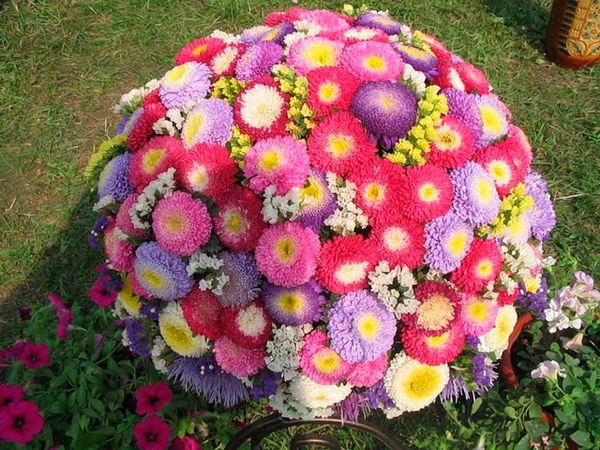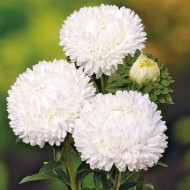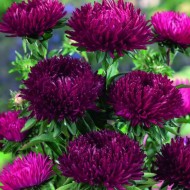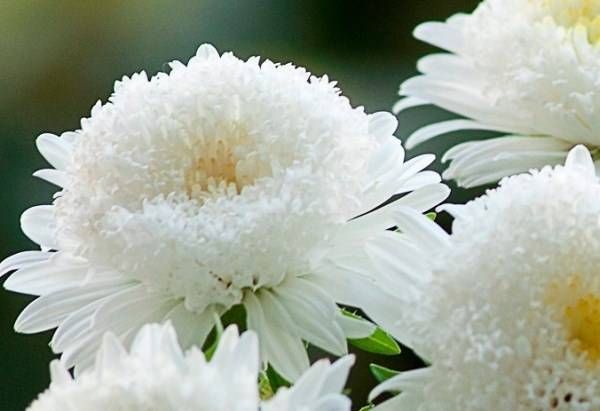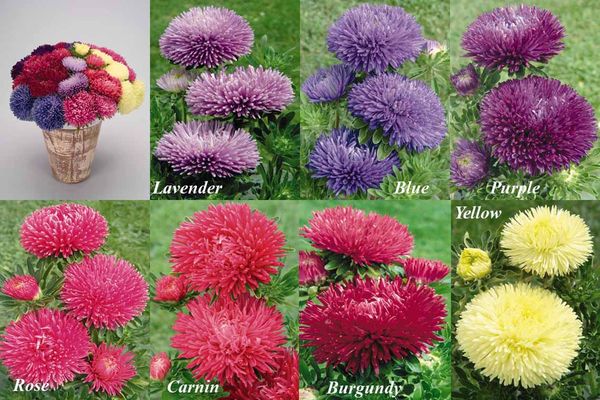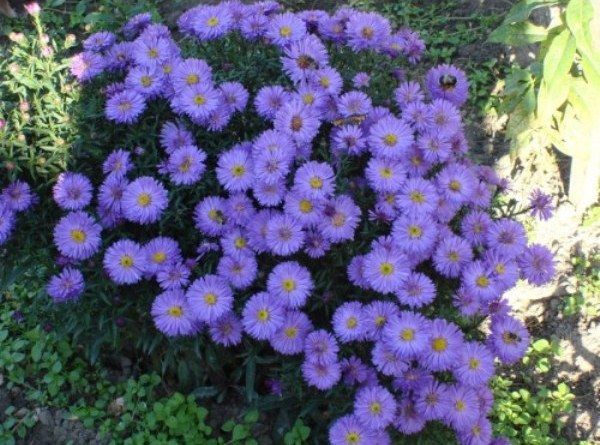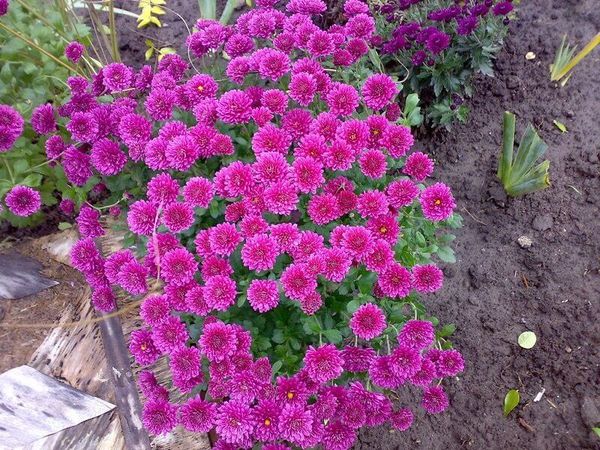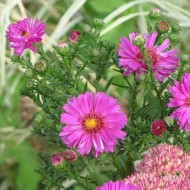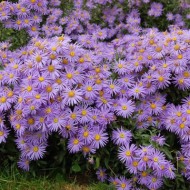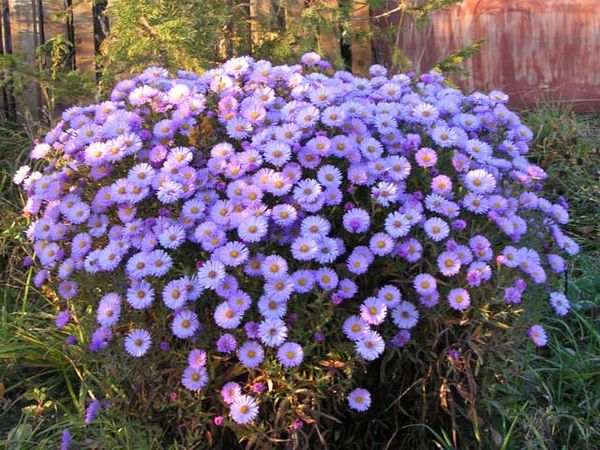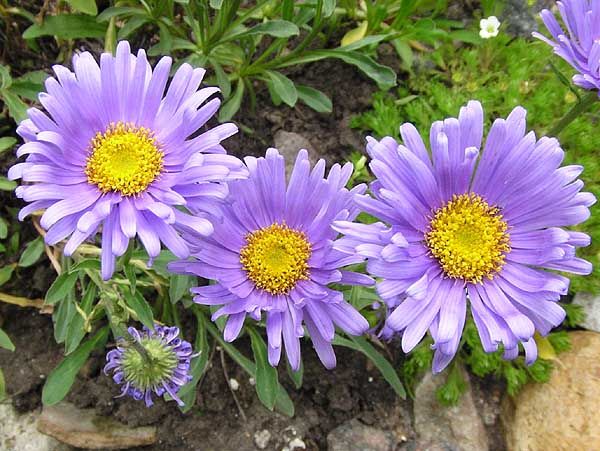A flower garden with a twist: the best varieties of asters for an original flower bed
Content
Description of the plant
Flowers are available to absolutely everyone. They attract the attention of gardeners with their unpretentiousness and beauty. Asters are often planted using seedlings. As a rule, the height of the plant ranges from 10 to 150 cm. Externally, the flowers resemble small stars, while each flower has its own unique characteristics depending on the variety.
At the moment, more than 200 types of asters have been bred, among which the following can be distinguished: Frekarta Monk, Rose Thurm, Delightful mixture, Classic, Royal Ruby, Montpensier, Pink, Gray-haired lady, Princess, Dragon.
Video "How to sow asters before winter"
In this video, the expert will tell you how to sow asters correctly before winter.
Classification
In order to choose the right variety for a flower garden or a summer cottage, it is recommended that you familiarize yourself with the classification of asters for various reasons:
- Height. Before sowing seeds or planting seedlings, you need to determine the planting site, taking into account the height: high - up to 80 cm; giant - above 80 cm; dwarf - a maximum of 25 cm; undersized - 35-40 cm; medium-sized - 60-65 cm.
- The structure of the bush. This parameter should also be taken into account, otherwise the flower beds will not look as neat as we would like. Given the structure, the bushes are spreading, strongly and weakly branched, as well as compact.
- The size of the inflorescences: giant - the size of the basket in diameter exceeds 12 cm; large - diameter from 9 to 11 cm; medium - up to 8 cm; small - no more than 4 cm.
- Inflorescence shape: ligulate; transitional - with reeds and tubes; tubular. In general, they are terry, spherical, flat, densely double, etc.
- In order to choose the right variety, it is important to understand the purpose for which the flowers will be grown. According to their purpose, they are divided as follows: universal varieties with longish peduncles - due to the medium size, the flowers are grown for cutting; undersized and dwarf - used as decoration due to the fact that small inflorescences form a ball; tall plants - have large flowers, are used for flower bouquets.
Popular annual species
Listed below are the popular varieties of annual asters with a brief description.
Galaxy
The plant reaches a height of 70 cm. It is often used for bouquets. On one plant there are up to 24 branches with needle-like double flowers, their diameter is 10 cm. They bloom from July to August. The colors are different. Often they are planted singly or added to flower beds. Ideal for cutting.
Snow White
The average plant height is 70 cm, the inflorescences are double and double. The flowers are no more than 12 cm in diameter, but outwardly they are quite large and snow-white. Bloom profusely for at least two months. Flowers will keep freshness and beauty in bouquets for a long time. They are often planted in flower beds or grown for cutting.
Lady Coral
The large-flowered variety shows excellent resistance to Fusarium. On long stems there are large and beautiful inflorescences.There are many blossoming flowers on each branch, so even a single branch replaces a whole bouquet. Bud diameter - 16-17 cm. Lady Coral asters can be of several colors: cream, red, yellow, white, black or pink. The preservation of freshness, aroma and beauty in the bouquet is excellent, so the flowers are most often grown for cutting.
Cloud
Asters of this variety are versatile, they are grown both for flower arrangements and for garden decoration. Shrubs grow up to 75 cm, acquiring a semi-spreading shape. Resistant to fusarium, as well as to sudden changes in temperature.
The diameter of semi-double inflorescences does not exceed 11 cm. The name was given to the variety for a reason. Outwardly, the flowers resemble a bride's veil or a light cloud, which will delight the eye even for the most demanding and sophisticated lovers of beauty.
Gala
The pyramid is exactly the shape that the flowers of this variety have. The plant grows up to 80 cm in length, has densely double large inflorescences. As a rule, the diameter of the flowers is 12 cm. The variety begins to give color from August to September. The buds are pink, purple, beige, red and multi-colored.
Oktyabrina
Shrub asters bloom in summer, the plant grows up to 45 cm. On each branch, 10-11 flowers appear with a pronounced shade. The inner row consists of tubular petals, the outer row consists of reed petals. The size of the inflorescences does not exceed 8 cm.
Perennials
Height and shades are parameters that are strikingly different for perennial asters. Tall plants most often grow in hotel flower beds and flower beds, and dwarf plants grow on alpine hills. Judging by the reviews, gardeners prefer perennial varieties, especially since their choice is rich and varied.
Virgin
As for the characteristics, the sizes of the plants range from 30 cm to 0.5 m. They are used to decorate the autumn garden. As a rule, inflorescences of such varieties are not more than 3 cm in diameter. Strong, but thin stems branch well, creating a dense and beautiful bush. Flowering begins in the first days of September.
Popular varieties:
- Marie Ballard. Vigorous garden bushes with blue inflorescences, plant height - up to 95 cm. Bloom for about two months, suitable for bouquets.
- Violetta. A compact shrub with purple-blue flowers. It is recommended to plant at the beginning of the flower garden so that it is not overshadowed by other plants.
- White Lady. White or light purple petals, small flowers, ideal for group plantings.
Italian
They look like daisies. These are low bushes - up to 70 cm. In July, the first flowers appear. The petals come in the following shades: lilac, blue, purple, blue or lavender.
The best Italian varieties are:
- Gnome - multi-colored chamomile asters. Numerous double flowers bloom on a spherical bush. The first petals are visible in July and last until frost. It is best not to plant the seeds in a shady area. Wind and rain do not affect decorativeness and beauty. Plants are often grown on balconies.
- Thomson - low-growing plants, reaching 45 cm in height. Flowering begins in July and continues until frost.
- Herman Lena is a variety that guarantees abundant flowering. Petals of a light purple hue often grow.
- Rose - tubular petals are light brown, and reed - pink. The basket is no more than 4 cm in diameter. Ideal for compositions and bouquets.
New English
New England varieties have a lush flowering, which starts in September and lasts until the first frost. There are two popular varieties:
- Bars Pink - refers to tall, reaching one and a half meters in height. The diameter of the carpal inflorescences does not exceed 4 cm. The petals are yellow or carmine. They are combined with other plants, including steppe plants. Suitable for cutting.
- Constgans - inflorescences of a tall bush are collected in the brush. Thanks to the petals and leaves, a green-purple carpet is obtained.
Dwarf alpine
They open in small or large buds. The varieties recommended by experienced florists:
- Dunkle Schone is a bush aster, visually reminiscent of a chamomile: with a yellow "inside" and purple tongue petals. The variety is resistant to frost, looks beautiful in flower beds.
- Rosea is a long-flowering variety. Pleasing to the eye from June until the first frost. Outwardly, the buds resemble a wild rose.
- Goliath are elongated green leaves that sit tightly on the stem. Delicate purple flowers bloom for only a month.
Tibetan
They are distinguished by abundant flowering. The baskets are usually blue. Flowers of the Anderson variety are the smallest representatives, because the plant height is up to 8 cm. The varieties are little known on the Russian market.
Growing features
It is worth remembering that the seedlings are planted at the end of May. Almost all varieties, including King Size, are capable of withstanding temperatures as low as -4 ° C. Before planting, you need to dig up the beds and make small holes, keeping a distance of 20 cm. After planting, the plant is watered.
Plants themselves are not whimsical. They like both the light of the sun and the light shade. If the leaves begin to wilt, this indicates drought. Asters don't need to be poured, but they still love regular watering. It is recommended to loosen the soil every time it rains or ends watering.
As for leaving, annual varieties need to be fed 14 days after planting, perennial ones after 2 years. Potassium sulfate and superphosphate are often used to make the mixture.
Reviews
Elena, 45 years old (Elektrostal): “That year I planted the American Beauty variety, I'm happy with the flowers. It's not hard to look after, I fertilized only once. I use it for beauty. "
Olga, 38 years old (Tula): “I prefer perennial varieties. Once planted, and bloom for several years. I don’t do bouquets, but for myself at the dacha it’s what I need. The shade doesn't matter, that's why I use different kinds of soot. "
Everyone likes asters. For the first of September, they are simply irreplaceable. They will make the flower bed in the garden unusual and sophisticated. The main thing is to follow the recommendations for growing.

